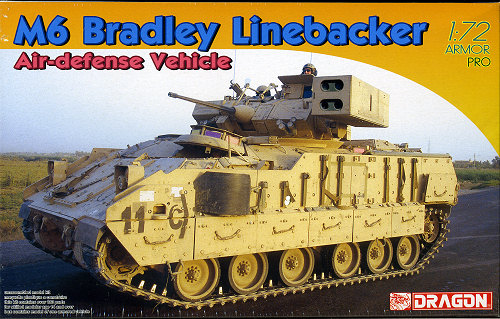
Dragon 1/72 M6 Bradley Linebacker
| KIT: | Dragon 1/72 M6 Bradley Linebacker |
| KIT #: | 7332 |
| PRICE: | $ |
| DECALS: | One Options |
| REVIEWER: | Scott Van Aken |
| NOTES: | Armor Pro kit |

| HISTORY |
The Bradley IFV was designed largely in response to the Soviet BMP family of infantry fighting vehicles, and to serve as both an APC, and a tank-killer. One specific design requirement was that it should be as fast as the new M1 Abrams main battle tank so that they could maintain formations while moving, something which the older M113 Armored Personnel Carrier could not do, as it had been designed to complement the older M60 Patton.
The 25 mm cannon fires up to 200 rounds per minute and is accurate up to 2500 m depending on the ammunition used (HE or APDS-T). The twin TOW2B missiles are capable of destroying most hostile tanks at a maximum range of 3750 m. A large drawback of the TOW is that it can only be fired while the vehicle is stationary. The Bradley also carries an M240C coaxial 7.62 mm medium machine gun, located to the right of the 25 mm chain gun. It is highly capable in cross-country open terrain, in accordance with one of the main design objectives of keeping pace with the M1 Abrams main battle tank. Whereas the M113 would float without much preparation, the Bradley was initially designed to float by deploying a flotation curtain around the vehicle. This caused some drownings due to failures during its first trials. Armor upgrades negate this capability.
The vehicle hull is of aluminum construction, one of the points used by critics to deride the vehicle. Aluminum armor tends to vaporize in the face of HEAT warheads; this and the storage of large quantities of ammunition in the vehicle initially raised questions about its combat survivability. Spaced laminate belts and high hardness steel skirts have been added to later versions to improve armor protection, although this increases overall weight to 33 tons. Actual combat operations, however, have not shown the Bradley to be overtly deficient as losses have been few. In friendly fire incidents in Desert Storm, many crew members survived hits that resulted in total losses for lighter USMC LAV 25 vehicles.
USAF LTC James Burton conducted highly publicized live fire tests where it was found that the center of the vehicle was most likely to be hit. His efforts to redesign the Bradley were not fully implemented; Bradleys still store their fuel dangerously in the vehicle center, whereas M113A3s have their fuel stored on the left and right rear to prevent fires/explosions inside the troop compartment. Despite this perceived vulnerability, the Bradley Fighting Vehicle has proven to be highly survivable when hit by enemy fire.
The Bradley series has been widely modified. Its chassis is the basis for the M270 Multiple Launch Rocket System, the M4 C2V battlefield command post, and the M6 Bradley Linebacker air defense vehicle. Armed with a quad Stinger surface to air missile launcher (instead of the TOW anti-tank missiles) and maintaining the 25 mm autocannon, the M6 Bradley Linebacker Air Defense Vehicle (and subject of this kit) possesses a unique role in the U.S. Army, providing highly mobile air defense at the front line. Unfortunately, this variant, despite being superior to the other mobile anti-air systems in use today, is about to be retired. Its suspension system has also been used on upgraded versions of the US Marines' Amphibious Assault Vehicle.
The total cost of the program is $5,664,100,000, and the average unit costs $3,166,000. As of early 2006, total combat losses since the invasion of Iraq included 55 Bradleys.
| THE KIT |
 This kit has quite a few parts (130 according to the box) and so the box is well packed with pieces. There are several new ones that are unique to this kit, including a new upper turret piece. The Stinger launcher is able to be mounted in several positions and the ramp can also be displayed up or down. As is typical of vehicles operating in Iraq, there is a considerable amount of additional armor for this variant. It is all superbly detailed.
This kit has quite a few parts (130 according to the box) and so the box is well packed with pieces. There are several new ones that are unique to this kit, including a new upper turret piece. The Stinger launcher is able to be mounted in several positions and the ramp can also be displayed up or down. As is typical of vehicles operating in Iraq, there is a considerable amount of additional armor for this variant. It is all superbly detailed.
The road wheels, idler and sprocket are all attached using polycaps, so that should make painting a lot easier for these. The set also uses the one-piece DS tracks. These are quite nice and hold paint just like standard styrene. They also glue quite easily. A small photo etch fret is includes that has but five pieces, all used to enhance already provided plastic parts. Instructions are well done and superbly drawn. A small decal sheet is for a single 'RLM 79' colored vehicle of the 42nd ID in 2005.
| CONCLUSIONS |
Another superlative Dragon small armor kit. This is not for the tyro, but if you have experience with similarly detailed kits, the end result will be one that you'll be pleased to display on your shelves. What's more, these are an excellent value for the money.
| REFEENCES |
February 2008
My thanks to www.dragonmodelsusa.com for the review kit. Get yours at your favorite shop or ask them to order it for you.
If you would like your product reviewed fairly and fairly quickly, please contact the editor or see other details in the Note to Contributors.